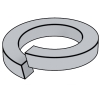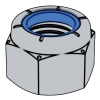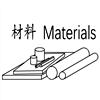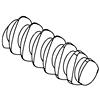
|
| No dimensional drawings!
Unit:
|

|
| No dimensional drawings!
Unit:
|
4 化学成分
按本部分生产的自攻螺钉适用的不锈钢化学成分在表2中给出。
注:表2 给出的化学成分与GB/T3098.6-2014 表1有关组别的化学成分是一致的。
除非之前购买者与制造者另有协议,否则在规定的钢的组别范围内的化学成分由制造者选择。
在有晶间腐蚀倾向的场合,推荐按GB/T 4334的规定进行试验。在此情况下,推荐采用稳定型的A3和A5,或者采用含碳量不超过0.03%的A2和A4不锈钢。
表2 不锈钢组别化学成分
类别 | 组别 | 化学成分a(质量分数)/% | 注 | ||||||||
C | Si | Mn | P | S | Cr | Mo | Ni | Cu | |||
奥氏体 | A2 | 0.10 | 1 | 2 | 0.05 | 0.03 | 15~20 | /b | 8~19 | 4 | cd |
A3 | 0.08 | 1 | 2 | 0.045 | 0.03 | 17~19 | /b | 9~12 | 1 | e | |
A4 | 0.08 | 1 | 2 | 0.045 | 0.03 | 16~18.5 | 2~3 | 10~15 | 4 | df | |
A5 | 0.08 | 1 | 2 | 0.045 | 0.03 | 16~18.5 | 2~3 | 10.5~14 | 1 | ef | |
马氏体 | C1 | 0.09~0.15 | 1 | 1 | 0.05 | 0.03 | 11.5~14 | / | 1 | / | f |
C3 | 0.17~0.25 | 1 | 1 | 0.04 | 0.03 | 16~18 | / | 1.5~2.5 | / | / | |
铁素体 | F1 | 0.12 | 1 | 1 | 0.04 | 0.03 | 15~18 | /g | 1 | / | hi |
注1:不锈钢的类别和组别,以及涉及其特性和应用的说明,在附录A中给出。 注2:已由ISO 4954标准化了的不锈钢材料示例,分别在附录A和附录B中给出。 注3:某些特殊用途的材料,在附录C中给出。 | |||||||||||
a 除另有表示外,均为最大值。 b 由制造者决定可以有钼含量,但对某些使用场合,如有必要限定钼的极限含量时,则应在订单中由用户注明。 c 如铬含量低于17%,则镍的最小含量应为12%。 d 对最大含碳量达到0.03%的奥氏体不锈钢,氮含量最高可达到0.22%。 e 为稳定组织,钛含量应为≥(5×C%)~ 0.8%,并应按本表适当标志,或者铌和/或钽含量应为≥(10×C%)~ 1.0%,并应按本表规定适当标志。 f 对较大直径的产品,为达到规定的机械性能,由制造者决定可以用较高的含碳量。但对奥氏体钢不应超过0.12%。 g 由制造者决定可以有钼含量。 h 钛含量可能为≥(5×C%)~ 0.8%。 i 铌和/或钽含量应为≥(1O×C%)~ 1.0%。 | |||||||||||
5 机械性能
5.1 通则
5.2~5.5规定的机械性能与工作性能适用于验收检查,并应按6.1~6.4的规定进行试验。
5.2 表面硬度
按6.1的规定进行试验时,马氏体钢螺钉的表面硬度应符合表3的规定。
表3 表面硬度
类别 | 组别 | 性能等级 | 表面硬度 HV min |
马氏体 | C1 | 30H | 300 |
C3 | 40H | 400 |
5.3 芯部硬度
按6.2的规定进行试验时,奥氏体和铁素体钢自攻螺钉的芯部硬度应符合表4的规定。如有争议,应按5.5条规定的工作性能进行产品的验收检查。
表4 芯部硬度
类别 | 组别 | 硬度等级 | 芯部硬度 HVa min |
奥氏体 | A2、A3、A4、A5 | 20H | 200 |
25H | 250 | ||
铁素体 | F1 | 25H | 250 |
a 螺纹规格≤ST3.9,应使用5HV;螺纹规格>ST3.9,应使用10HV。 | |||
5.4 抗扭强度
按6.3的规定进行试验时,不锈钢自攻螺钉的破坏扭矩应等于或大于表5对各硬度等级分别给出的最小扭矩值。
5.5 螺纹成形能力
按6.4的规定拧入试验板时,不锈钢自攻螺钉应能攻出与其匹配的内螺纹,而螺钉的螺纹不应损坏。
6 试验方法
6.1 表面硬度试验
本试验适用于马氏体钢自攻螺钉。
维氏硬度试验应按GB/T 4340.1的规定进行。
棱锥压痕应压在平面上,并优先在螺钉头部进行。
6.2 芯部硬度试验
本试验适用于奥氏体和铁素体钢自攻螺钉。
维氏芯部硬度试验按GB/T 4340.1的规定,并应在距螺钉末端有足够距离(应有完整的螺纹小径)的横截面的1/2 半径处进行。
6.3 破坏扭矩试验
使用图2所示的装置施加己确定的破坏扭矩 MB 。该扭矩测量仪器的误差不应大于测量的最小扭矩值的±6%。
经尺寸等检验合格的自攻螺钉试件的螺纹部分(有镀层或无镀层的)应夹紧在螺钉螺纹相匹配的开合螺纹模具或其他装置内;螺钉夹紧部分不应损伤,且至少有两扣完整螺纹伸出夹紧装置、除螺钉末端外至少有两扣完整螺纹夹紧在夹具内。夹紧装置应有带内螺纹的盲孔夹具(图2),孔的深度应保证断裂发生在完整螺纹部分。
对螺钉施加扭矩,直至断裂。螺钉试件应符合表5规定的最小破坏扭矩。
表5 最小破坏扭矩
螺纹 | 破坏扭矩 MB , min | |||
硬度等级 | ||||
20H | 25H | 30H | 40H | |
ST2.2 | 0.38 | 0.48 | 0.54 | 0.6 |
ST2.6 | 0.64 | 0.8 | 0.9 | 1 |
ST2.9 | 1 | 1.2 | 1.4 | 1.5 |
ST3.3 | 1.3 | 1.6 | 1.8 | 2 |
ST3.5 | 1.7 | 2.2 | 2.4 | 2.7 |
ST3.9 | 2.3 | 2.9 | 3.3 | 3.6 |
ST4.2 | 2.8 | 3.5 | 3.9 | 4.4 |
ST4.8 | 4.4 | 5.5 | 6.2 | 6.9 |
ST5.5 | 6.9 | 8.7 | 9.7 | 10.8 |
ST6.3 | 11.4 | 14.2 | 15.9 | 17.7 |
ST8 | 23.5 | 29.4 | 32.9 | 36.5 |

说明:
1一一螺纹模或衬套;
2一一盲孔内螺纹;
3一一螺纹开合模。
图2 破坏扭矩 M B的测试装置
6.4 拧入性能试验
经尺寸等检验合格的自攻螺钉试件(有镀层或无镀层的)应拧入试验板内,直至有一扣完整螺纹完全通过试验板。
奥氏体和铁素体钢自攻螺钉的拧入性能试验,应使用由铝合金制成的、硬度为80 HV30 ~ 120 HV30 的试验板。
马氏体钢自攻螺钉的拧入性能试验,应使用由含碳量≤0.23% 的低碳钢制成的、硬度为130 HV30 ~ 170 HV30 (按GB/T 4340.l 测定)的试验板。
试验板的厚度应符合表6给出的数值。
试验孔可由钻孔或先冲孔再钻孔,或先冲孔再铰孔制成,其孔径按表6规定。
表6 试验板的厚度和孔径
螺纹 | 试验板的厚度/mm | 孔径/mm | ||
Min. | Max. | Min. | Max. | |
ST2.2 | 1.17 | 1.30 | 1.905 | 1.955 |
ST 2.6 | 1.17 | 1.30 | 2.185 | 2.235 |
ST2.9 | 1.17 | 1.30 | 2.415 | 2.465 |
ST3.3 | 1.17 | 1.30 | 2.680 | 2.730 |
ST3.5 | 1.85 | 2.06 | 2.920 | 2.970 |
ST3.9 | 1.85 | 2.06 | 3.240 | 3.290 |
ST4.2 | 1.85 | 2.06 | 3.430 | 3.480 |
ST4.8 | 3.10 | 3.23 | 4.015 | 4.065 |
ST5.5 | 3.10 | 3.23 | 4.735 | 4.785 |
ST6.3 | 4.67 | 5.05 | 5.475 | 5.525 |
ST8 | 4.67 | 5.05 | 6.885 | 6.935 |
表A.1 铁素体-奥氏体组织钢的成分示例
钢的类别 | 化学成分(质量分数)/% | ||||||
C,max | Si | Mn | Cr | Ni | Mo | N | |
铁素体-奥氏体 | 0.03 | 1.7 | 1.5 | 18.5 | 5 | 2.7 | 0.07 |
0.03 | <1 | <2 | 22 | 5.5 | 3 | 0.14 | |
表B.1 冷辙和冷挤压用不锈钢
类型标记a | 化学成分(质量分数)/% | 组别标记c | ||||||||||
序号 | 名称 | ISO 4954:1979 | C | Si max | Mn max | P max | S max | Cr | Mn | Ni | 其他 | |
铁素体钢 | ||||||||||||
71 | X3 Cr 17 E |
| ≤0.04 | 1.00 | 1.00 | 0.040 | 0.030 | 16.0~18.0 | 0.90~13.0 | ≤1.0 |
| F1 |
72 | X6 Cr 17 E | D1 | ≤0.08 | 1.00 | 1.00 | 0.040 | 0.030 | 16.0~18.0 | ≤1.0 | F1 | ||
73 | X6 CrMo 17 1 E | D2 | ≤0.08 | 1.00 | 1.00 | 0.040 | 0.030 | 16.0~18.0 | ≤1.0 | F1 | ||
74 | X6 CrTi 12 E | / | ≤0.08 | 1.00 | 1.00 | 0.040 | 0.030 | 10.5~12.5 | ≤0.50 | Ti:6×%C≤1.0 | F1 | |
75 | X6 CrNb 12 E | / | ≤0.08 | 1.00 | 1.00 | 0.040 | 0.030 | 10.0~12.5 | ≤0.50 | Nb:6×%C≤1.0 | F1 | |
马氏体钢 | ||||||||||||
76 | X12 Cr 13 E | D10 | 0.90~0.15 | 1.00 | 1.00 | 0.040 | 0.030 | 11.5~13.5 |
| ≤1.0 |
| C1 |
77 | X19 CrNi 16 2 E | D12 | 0.14~0.23 | 1.00 | 1.00 | 0.040 | 0.030 | 15.0~17.5 | 1.5~2.5 | C3 | ||
奥氏体钢 | ||||||||||||
78 | X2 CrNi 18 10 E | D20 | ≤0.030 | 1.00 | 2.00 | 0.045 | 0.030 | 17.0~19.0 |
| 9.0~12.0 |
| A2d |
79 | X5 CrNi 18 9 E | D21 | ≤0.07 | 1.00 | 2.00 | 0.045 | 0.030 | 17.0~19.0 |
| 8.0~11.0 |
| A2 |
80 | X10 CrNi 18 9 E | D22 | ≤0.12 | 1.00 | 2.00 | 0.045 | 0.030 | 17.0~19.0 |
| 8.0~10.0 |
| A2 |
81 | X5 CrNi 18 12 E | D23 | ≤0.07 | 1.00 | 2.00 | 0.045 | 0.030 | 17.0~19.0 |
| 11.0~13.0 |
| A2 |
82 | X6 CrNi 18 16 E | D25 | ≤0.08 | 1.00 | 2.00 | 0.045 | 0.030 | 15.0~17.0 | 2.0~2.5 | 17.0~19.0 |
| A2 |
83 | X6 CrNiTi 18 10 E | D26 | ≤0.030 | 1.00 | 2.00 | 0.045 | 0.030 | 17.0~19.0 | 2.0~2.5 | 9.0~12.0 | Ti:5×%C≤0.80 | A3e |
84 | X5 CrNiMo 17 12 2 E | D29 | ≤0.037 | 1.00 | 2.00 | 0.045 | 0.030 | 16.5~18.5 | 2.5~3.0 | 10.5~13.5 |
| A4 |
85 | X6 CrNiMo Ti 17 12 2 E | D30 | ≤0.08 | 1.00 | 2.00 | 0.045 | 0.030 | 16.5~18.5 | 2.5~3.0 | 11.0~14.0 | Ti:5×%C≤0.80 | A5 e |
86 | X2 CrNiMo 17 13 3 E | / | ≤0.030 | 1.00 | 2.00 | 0.045 | 0.030 | 16.5~18.5 |
| 11.5~14.5 |
| A4d |
87 | X2 CrNiMoN 17 13 3 E | / | ≤0.030 | 1.00 | 2.00 | 0.045 | 0.030 | 16.5~18.5 |
| 11.5~14.5 | N:0.12×%C≤0.22 | A4d |
88 | X3 CrNiCu 18 9 3 E | D32 | ≤0.04 | 1.00 | 2.00 | 0.045 | 0.030 | 17.0~19.0 |
| 8.5~10.5 | Cu: 3.00~4.00 | A2 |
a 第1列的标记是顺序编号。第2列的标记是根据ISO/TC17/SC2建议的标记制度。第3列的标记是在 ISO 4954:1979(1993修订)中使用并已作废的编号。 b 本表未列出的元素,未经用户同意,不能增加,除非要精炼。应采用合理的预防措施,以防止某些元素(来自制造过程中混入的废料或其他金属)的增加,因为这些元素会影响材料的淬透性、机械性能和使用性能。 c 不是 ISO 4954 的内容。 d 有极好的耐晶间腐蚀性。 e 稳定型钢。 | ||||||||||||
表C.1 耐氯化物导致应力腐蚀的奥氏体不锈钢
奥氏体不锈钢 | 化学成分(质量分数)/% | |||||||||
C | Si | Mn | P | S | N | Cr | Mo | Ni | Cu | |
X2CrNiMoN17-13-5 | 0.030 | 1.00 | 2.00 | 0.045 | 0.015 | 0.12~0.22 | 16.5~18.5 | 4.0~5.0 | 12.5~14.5 |
|
X1NiCrMoCu25-20-5 | 0.020 | 0.70 | 2.00 | 0.030 | 0.010 | ≤0.15 | 19.0~21.0 | 4.0~5.0 | 24.0~26.0 | 1.20~2.00 |
X1NiCrMoCu25-20-7 | 0.020 | 0.50 | 1.00 | 0.030 | 0.010 | 0.15~0.25 | 19.0~21.0 | 6.0~7.0 | 24.0~26.0 | 0.50~1.50 |
X2CrNiMoN22-5-3a | 0.030 | 1.00 | 2.00 | 0.035 | 0.015 | 0.10~0.22 | 21.0~23.0 | 2.5~3.5 | 4.5~6.5 |
|
a 奥氏体-铁素体不锈钢 | ||||||||||
Mechanical properties of fasteners - Stainless steel Bolts, screws and studs
Mechanical properties of fasteners-Stainless steel and nickel alloys bolts, screws, studs and nuts for high temperature applications
Mechanical properties of fasteners-Guidance for the selection of stainless steels and nickel alloys for fasteners
Mechanical Properties of Fasteners - Prevailing Torque Type Steel Nuts
Mechanical properties of fasteners-Set screws

Mechanical properties of fasteners-nuts with coarse thread
High-strength structural bolting assemblies for preloading - Part2: Suitability for preloading

Mechanical properties of fasteners - Stainless steel nuts

Mechanical properties of fasteners - Stainless steel set screws

Mechanical properties of fasteners - Stainless steel Bolts, screws and studs

Mechanical properties of fasteners-Bolts、screws and studs

Mechanical properties of fasteners Parts for bolted connections for use at temperatures from -200 ℃~+700 ℃

Mechanical properties of fasteners made of the fine grain non-heat treatment steel-Bolts,screws and studs

Spring washer technical conditions


Mechanical properties of fasteners-Blind rivets

Mechanical properties of fasteners. Wing nuts with specified proof torque

Mechanical properties of fasteners-Drilling screws with tapping screws thread

Mechanical properties of fasteners. Prevailing torque type steel hexagon nuts

Mechanical properties of fasteners-Nuts-Fine pitch thread

Mechanical propretles of fasteners tapping screws

Mechanical properties of fasteners-Bolts、screws and studs made of stainless-steel

Machanical properties of fasteners-Thread rolling screws

Mechanical properties of fasteners Bolts,scrows,studs and nuts made of non-ferrous metals

Specification for revit
Mechanical Properties of Fasteners 一 Tapping Screws
Fasteners - Mechanical properties of corrosion-resistant stainless steel fasteners - Part 7: Flat washers with specified grades and property classes
Heat treated tapping screws - Mechanical and physical properties
Mechanical properties of fasteners made of carbon steel and alloy steel — Part 2: Nuts with specified property classes
Mechanical properties of corrosion-resistant stainless steel fasteners - Nuts with specified grades and property classes bsi.
Mechanical properties of fasteners made of carbon steel and alloy steel – Part 3: Flat washers with specified property classes
Mechanical Properties of Fasteners - Prevailing Torque Type Steel Nuts

Mechanical properties of fasteners made of carbon steel and alloy steel. Part 1:Bolts,screws and studs with specified property classes. Coarse thread

Mechanical properties of fasteners made of carbon steel and alloy steel - Part 2: Nuts with specifed property classes - Coarse thread and fne pitch thread

Mechanical properties—Set screw and similar threaded fasteners with specified hardness classes

Heat-treated steel tapping screws - Mechanical properties

Mechanical properties of corrosion resistant stainless steel fasteners—Part 1:Nuts

Mechanical properties of corrosion resistant stainless steel fasteners— Part 3:Set screws and similar fasteners not under tensile stress

Mechanical properties of corrosion resistant stainless steel fasteners— Part 4:Tapping screws

Drilling screws with tapping screw thread— Mechanical and functional properties

Mechanical and performance requirements of case hardened and tempered metric thread rolling screws
Mechanical properties of fasteners - Part 6: Nuts with specified proof load values - Fine pitch thread

Torsional test and minimum torques for bolts and screws

Mechanical properties of fasteners—Bolts,screws,studs and nuts made of non-ferrous metals
Heat-treated steel tapping screws - Mechanical properties
Test methods of tightening torque for bolts
Maximum Drive Torque for Type TRS Tapping Screws
Torsional Strength Requirements for Tapping Screws


Nylon Insert Locknuts (Inch Series)
Aerospace series - Bolts, MJ threads, in heat resisting steel FE-PA2601 (A286) - Classification: 900 MPa (at ambient temperature)/650℃ - Technical specification
Non-preloaded structural bolting assemblies - Part 1: General requirements
High-strength structural bolting assemblies for preloading - Part 2: Suitability for preloading
Mechanical properties of fasteners - Part 7: Torsional test and minimum torques for bolts and screws with nominal diameters 1 mm to 10 mm
Mechanical properties of fasteners - Part 2: Nuts with specified proof load values - Coarse thread
Mechanical properties of fasteners - Part 6: Nuts with specified proof load values - Fine pitch thread
Mechanical properties of fasteners - Part 1: Bolts, screws and studs
Mechanical Properties of Fasteners - Bolts, Screws, Studs and Nuts

Suppliers(1)
Carbon Steel Bolts, Studs, and Threaded Rod 6000 PSI Tensile Strength

Carbon steels、alloy steels and stainless materials for bolts and nuts
Mechanical properties of fasteners made of carbon steel and alloy steel Part 2: Nuts with specified property classes - Coarse thread and fine pitch thread
Mechanical properties of fasteners made of carbon steel and alloy steel. Part 1:Bolts,screws and studs
Self-drilling screws for the building and construction industries Part 1: General requirements and mechanical properties

Thread Rolling Screws
Maximum Drive Torque for Type TRS Tapping Screws
Torsional Strength Requirements for Tapping Screws
